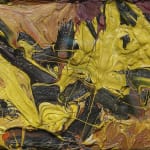Frank Auerbach 1931-2024
E.O.W. on her Bed, 1969
oil on board
12.7 x 20.3 cm / 5 x 8 inches
Further images
This small, jewel-like painting is one of a sequence of eight oils that Frank Auerbach produced in 1969 depicting E.O.W. in profile, reclining on the bed, her hair spreading up...
This small, jewel-like painting is one of a sequence of eight oils that Frank Auerbach produced in 1969 depicting E.O.W. in profile, reclining on the bed, her hair spreading up the pillow above her head, a composition he returned to in a later painting in 1982 using his cousin Gerda Boehm as the subject.1 Measuring just 5 by 8 inches, this painting is the smallest in the series and the closest crop, with the sitter’s nose pushing against the top edge of the board. Although, to varying degrees, all of Auerbach’s depictions of E.O.W. reveal a sense of familiarity, the small scale of the present work, and the view it offers of the subject, exudes a particularly charged intimacy. Unlike the seven other paintings in the sequence, which are on square supports, the present work is distinguished by its horizontal format. Importantly, a painting from this series (wf 257) was at one time in the collection of the artist’s close friend Lucian Freud, who amassed what is now regarded as one of the greatest private collections
of Auerbach’s works.
For Auerbach, a single portrait may take many weeks or months to complete. This is due to his laborious technique of painting the entire surface and then, if he is dissatisfied, scraping off the whole day’s work, to allow him to start from scratch at the next session. Of his approach Auerbach has said, ‘I don’t think one produces a great picture unless one destroys a good one in the process.’ 2 While another small painting of the sitter, Head of E.O.W., 1955 (8 ½ by 6 inches), took Auerbach a
remarkable two years and 300 sittings to complete, we know that in 1969 alone the artist managed to paint six of the eight oils of E.O.W.’s reclining head, including the present work. Auerbach has spoken of his sense of urgency when working from the model and this is felt acutely in this painting. Unlike earlier works, such as E.O.W. on her Blue Eiderdown, VI, 1963 (cat.25), in which the paint appears dry and encrusted, here there is a real sense of the liquidity of the paint. Pools of bright yellow oil stream across the picture surface, interrupted by glossy black brush marks and delicate tendrils of criss-crossing paint.
1 The series of eight portraits of E.O.W. in profile have the following cat nos. in Feaver’s 2009 catalogue raisonné: 256 – 263
2 The artist in conversation with William Feaver, Frank Auerbach, Rizzoli, New York, 2009, p230
of Auerbach’s works.
For Auerbach, a single portrait may take many weeks or months to complete. This is due to his laborious technique of painting the entire surface and then, if he is dissatisfied, scraping off the whole day’s work, to allow him to start from scratch at the next session. Of his approach Auerbach has said, ‘I don’t think one produces a great picture unless one destroys a good one in the process.’ 2 While another small painting of the sitter, Head of E.O.W., 1955 (8 ½ by 6 inches), took Auerbach a
remarkable two years and 300 sittings to complete, we know that in 1969 alone the artist managed to paint six of the eight oils of E.O.W.’s reclining head, including the present work. Auerbach has spoken of his sense of urgency when working from the model and this is felt acutely in this painting. Unlike earlier works, such as E.O.W. on her Blue Eiderdown, VI, 1963 (cat.25), in which the paint appears dry and encrusted, here there is a real sense of the liquidity of the paint. Pools of bright yellow oil stream across the picture surface, interrupted by glossy black brush marks and delicate tendrils of criss-crossing paint.
1 The series of eight portraits of E.O.W. in profile have the following cat nos. in Feaver’s 2009 catalogue raisonné: 256 – 263
2 The artist in conversation with William Feaver, Frank Auerbach, Rizzoli, New York, 2009, p230
Provenance
Private Collection, UKBernard Jacobson, London
Private Collection, UK







